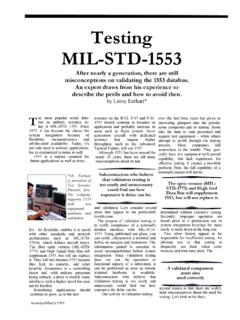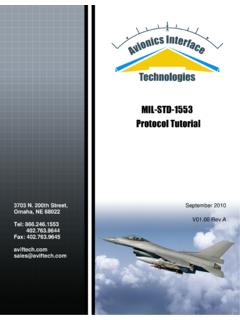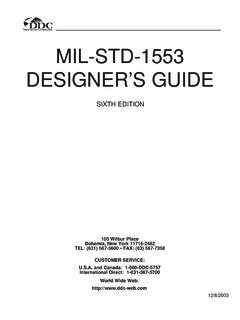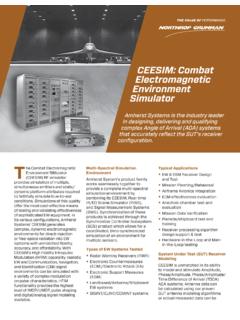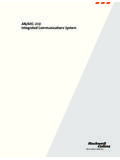Transcription of Tutorial - bjklrs.com
1 MIL-STD- 1553 Tutorial Copyrights Software Copyright 1993-2000 Condor Engineering, Inc. This software product is copyrighted and all rights are reserved. The distribution and sale of this product are intended for the use of the original purchaser only per the terms of the License Agreement. This User s Manual is copyrighted and all rights are reserved. This document may not, in whole or part, be; copied; photocopied; reproduced; translated; reduced or transferred to any electronic medium or machine-readable form without prior consent in writing from Condor Engineering, Inc. Microsoft is a registered trademark of Microsoft Corporation Windows is a registered trademark of Microsoft Corporation MIL-STD- 1553 Tutorial (1600100-0028) Condor Engineering, Inc.
2 Santa Barbara, CA 93101 (805) 965-8000 (805) 963-9630 (fax) Document Revision: June 5, 2000 Document Version: Software Revision: MIL-STD- 1553 Tutorial i Contents and Tables Contents Chapter 1 Overview Interface Description .. 1 2 The Advent of Digital 2 The Advent of the Data Bus .. 3 History and 5 Notice 1 and Notice 2 .. 5 MIL-STD- 1553 Applications .. 6 MIL-STD-1553B Defined .. 6 Chapter 2 Hardware Elements Transmission Media .. 9 Multi-stub Couplers .. 12 Remote Terminals .. 12 Bus 14 Word Controller .. 15 Message Controller .. 15 Frame Controller .. 15 Bus Monitor .. 16 Terminal 16 Chapter 3 Protocol Word Types .. 19 Sync Fields .. 21 Command Words .. 21 Data Word .. 23 Status Word .. 23 Resetting of the Status Word .. 23 Terminal Address .. 24 Message Error .. 24 Instrumentation.
3 24 ii MIL-STD- 1553 Tutorial Service Request .. 25 Reserved .. 25 Broadcast Command 25 Busy .. 26 Subsystem Flag .. 26 Dynamic Bus Control Acceptance Bit .. 27 Terminal Flag .. 27 Chapter 4 Message Formats 29 Bus Controller to Remote 31 Remote Terminal to Bus 31 Remote Terminal to Remote Terminal .. 31 RT-RT Validation .. 32 Mode Command 32 Broadcast Information Transfer 33 Command and Message Validation .. 33 Illegal Commands .. 34 Example 34 Example 35 Example 35 Terminal Response Time .. 35 Inter-message Gap .. 36 Superseding Commands .. 37 Chapter 5 Mode Codes 39 Mode Code Identifier .. 40 Dynamic Bus Control .. 41 Synchronize .. 42 Transmit Status 42 Initiate 43 Transmitter Shutdown .. 44 Override Transmitter 44 Inhibit Terminal 44 Override Inhibit Terminal Flag.
4 45 Reset Remote Terminal .. 45 Transmit Vector Word .. 46 Synchronize with Data Word .. 46 Transmit Last Command 47 Transmit Built-in-Test (BIT) Word .. 47 Selected Transmitter Shutdown .. 48 Override Selected Transmitter 48 MIL-STD- 1553 Tutorial iii Reserved Mode 48 Required Mode Codes .. 49 Broadcast Mode 50 Chapter 6 system Issues Using Subaddresses .. 51 Extended Subaddressing .. 51 Data Wrap-Around .. 52 Data Buffering .. 53 Variable Message Blocks .. 54 Sample 54 Data 54 Major/Minor Frame 55 Bus 57 Error Processing .. 58 Chapter 7 Connecting the Bus 61 Direct Coupled Bus .. 61 Transformer Coupled Bus .. 62 Mixed Bus Coupling .. 63 Primary and Secondary 63 More than Two Terminals .. 64 Cautions .. 65 The Single Bus Wiring Short 65 The Crossed Bus Wiring Short Cut.
5 66 The Two Bus/One Controller Short Cut .. 66 The Very Long Stub Short 66 The No Terminators Short Cut .. 66 The Connected Couplers Short 67 The Junk Wiring Short 67 Chapter 8 Testing 69 Government and SAE Test 69 Test 70 Chapter 9 Additional Information Sources of Information .. 73 iv MIL-STD- 1553 Tutorial Table of Figures Figure 1. system 4 Figure 2. Terminal Connection 11 Figure 3. Simple Multiplex Architecture .. 13 Figure 4. Terminal Definition .. 14 Figure 5. Word Formats .. 20 Figure 6. Data Encoding and Decoding .. 21 Figure 7. Information Transfer Formats .. 30 Figure 8. Information Transfer Formats (Broadcast) .. 30 Figure 9. Major/Minor Cycles .. 57 Figure 10. Direct 62 Figure 11. Transformer Coupling .. 62 Figure 12. Mixed Bus 63 Figure 13. Primary and Secondary Buses.
6 64 List of Tables Table 1. Summary of MIL-STD- 1553 Characteristics .. 7 Table 2. Summary of Transmission Media Characteristics .. 10 Table 3. Terminal Electrical Characteristics Input Characteristics .. 17 Table 4. Terminal Electrical Characteristics Input Characteristics .. 17 Table 5. Mode Codes .. 40 Table 6. Bus Loading Numbers .. 57 Table 7. Test Plans .. 69 MIL-STD- 1553 Tutorial 1 CHAPTER 1 Overview Interface Description MIL-STD- 1553 is a military standard that defines the electrical and protocol characteristics for a data bus. A data bus is used to provide a medium for the exchange of data and information between various systems. It is similar to what the personal computer and office automation industry has dubbed a Local Area Network (LAN). This guide provides an introduction to the MIL-STD- 1553 data bus, its history, applications, and use.
7 It describes: ! The physical elements that make up the bus. ! The protocol, including the message formats, word types, and command and status words. ! Status word bits and mode commands and their definitions and use, both from the remote terminal and bus controller perspective. ! Issues such as bus loading, major and minor frame timing, and error recovery. Additionally, this guide introduces the various test plans and discusses how the Condor MIL-STD- 1553 product line can solve some of your testing and application needs. Background Overview 2 MIL-STD- 1553 Tutorial Background In the 1950s and 1960s, aviation electronics, referred to as avionics, were simple stand-alone systems. The navigation, communications, flight controls, and displays consisted of analog systems. Often these systems were composed of multiple boxes, or subsystems, connected to form a single system .
8 Various boxes within a system were connected with point-to-point wiring. The signals mainly consisted of analog voltages, synchro-resolver signals, and switch contacts. The location of these boxes within the aircraft was a function of operator need, available space, and the aircraft weight and balance constraints. As more and more systems were added, the cockpits became more crowded, the wiring more complex, and the overall weight of the aircraft increased. By the late 1960s and early 1970s, it became necessary to share information between the various systems to reduce the number of black boxes required by each system . A single sensor, for example that provided heading and rate information, could provide that data to the navigation system , the weapons system , the flight control system , and pilots display system (see figure 1a).
9 However, the avionics technology was still basically analog, and while sharing sensors did produce a reduction in the overall number of black boxes, the connecting signals became a rat's nest of wires and con-nectors. Moreover, functions or systems that were added later became an integration nightmare, as additional connections of a particular signal could have potential system impacts. Additionally, as the system used point-to-point wiring, the system that was the source of the signal typically had to be modified to provide the additional hardware to output to the newly added subsystem. As such, inter- system connections had to be kept to the bare minimum. The Advent of Digital Technology By the late 1970s, with the advent of digital technology, digital computers had made their way into avionics systems and subsystems.
10 They offered increased computational capability and easy growth, compared to their analog predecessors. However, the data signals, inputs and outputs from the sending and receiving systems were still mainly analog in nature. This led to the configuration of a small number of centralized computers (typically only one or two) being interfaced to other systems and subsystems via complex and expensive analog-to-digital and digital-to-analog converters. As time and technology progressed, the avionics systems became more digital. And with the advent of the microprocessor, things really took off. A benefit of this digital application was the reduction in the number of analog signals, and hence the need for their conversion. Transferring the Overview Background MIL-STD- 1553 Tutorial 3 data between users in digital form could provide a greater sharing of sensor information.
